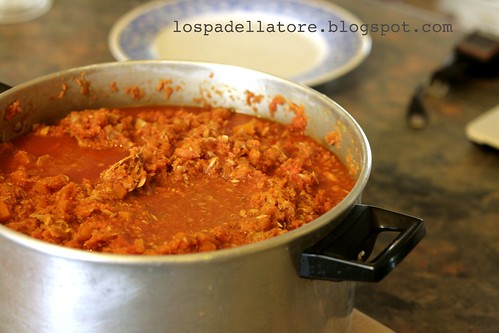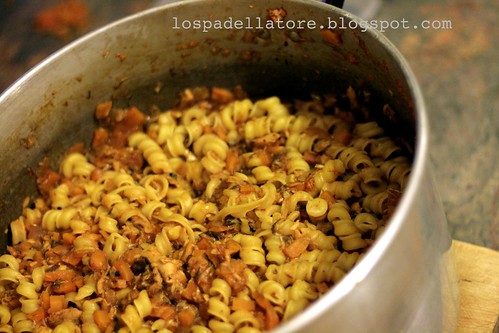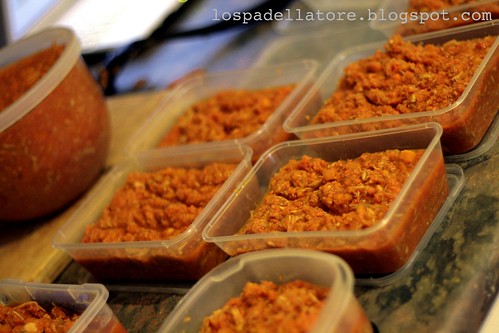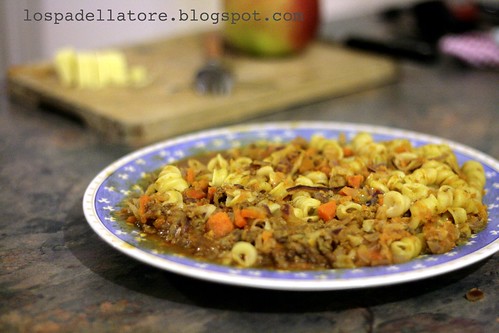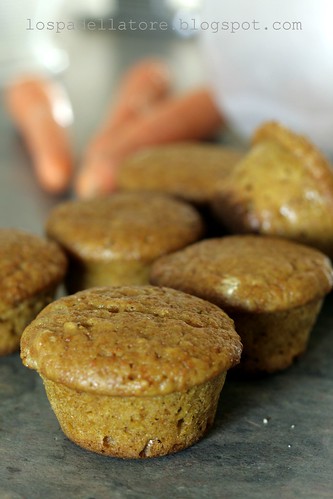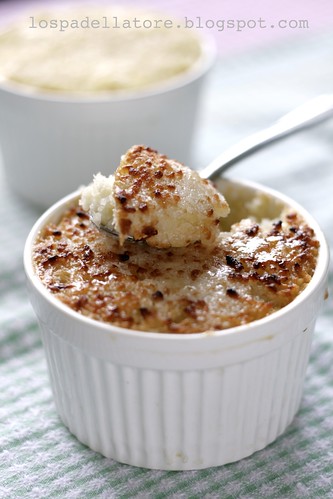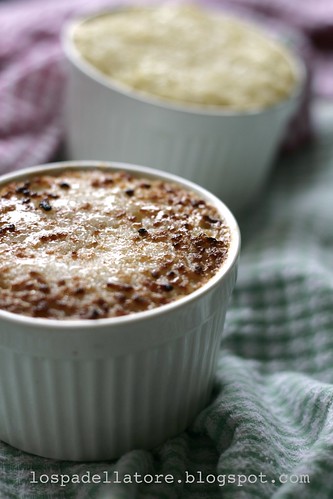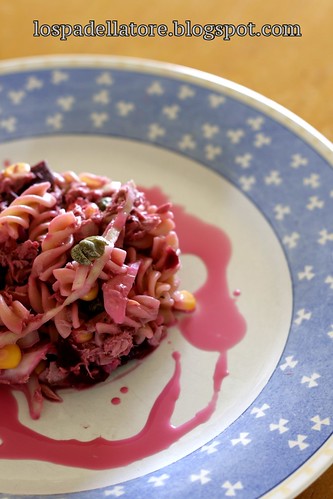English version here.
La foto
La storiellaDispensa, frigo e freezer erano vuoti dalla settimana scorsa. Così ho deciso di fare un altro dei miei esperimenti. :D Preparare tutti i pasti per le seguenti 2 settimane spendendo il meno possibile. Unico vincolo è stato un menù giornaliero di circa 1900 kcal che prevedesse una ripartizione di minimo 45% di carboidrati, 15% di proteine e 25% di grassi.
Ho usato questo per i calcoli.
Risultato: $31.31 dollari australiani (circa 24.5 Euro), $15 (11.72 euro) a settimana, $2.24 (1.75 euro) al giorno. Sembra impossibile, vero?
Ipotizziamo che un ipotetico Sig. Taccagno viva per un anno restando su questo budget.
D'altra parte consideriamo il suo collega, il Sig. Bellavita che non cucina mai a casa ed esce sempre a mangiare (le cifre sono abbastanza approssimative):
- 5 euro per la colazione
- 10 euro per il pranzo
- 20 euro a cena
Al giorno: 35 euro.
Alla fine dell'anno:
- Sig. Bellavita 35 x 365 = $12.775
- Sig. Taccagno 1.75 x 365 = $638,75
Il Sig. Bellavita vuole denunciare il Sig. Taccagno al fisco perché non capisce come possa avere più di 12.000 euro in banca rispetto a lui. :D
Ovviamente sono due casi estremi (o forse no?), i calcoli sono approssimativi e la realtà sta nel mezzo.
Morale della favola:
- se si vuole spendere meno, cucinarsi i pasti a casa: comprare ingredienti freschi economici di stagione e trasformarli in un sano e semplice piatto; se gli ingredienti sono buoni non serve fare "acrobazie" ai fornelli;
- è utile imparare a comprare in modo efficiente: pianificare il menù settimanale (o mensile) e comprare solo gli ingredienti necessari; essere flessibili e sostituire alcuni ingredienti con altri in offerta o più economici perché in stagione;
Mi fa sorridere quando sento "Non abbiamo soldi per arrivare a fine mese", specialmente quando vedo il frigo di queste persone pieno di avanzi che iniziano a "stagionare" e a produrre una bella patina di muffa (alla faccia della sicurezza alimentare della famiglia). Ho notato che molta gente compra un ingrediente che vogliono utilizzare in una nuova ricetta, ne usano 1/4 della confezione e poi mettono da parte. Può andar bene per le farine, riso e ingredienti secchi che possono essere conservati a lungo. Ma per quelli freschi come frutta, verdura, sottoaceti/olio, latticini lasciati in frigo a "fermentare" per giorni, settimane, mesi? Ecco come si produce lo spreco alimentare!
Soluzione: la prima volta che si compra un nuovo ingrediente, comprarne solo la quantità necessaria per la ricetta. Non comprare la confezione maxi solo perché è più conveniente di quella piccola... quello si può fare una volta realizzato che ti piace sul serio.
Se non si riesce a consumare tutto l'ingrediente:
- pianificare come utilizzare gli avanzi prima della data di scadenza; se non piace... basta imparare a farselo piacere! Io mi dico sempre "Se piace a qualcuno deve esserci la 'chiave' per capire perché è buono". Assaggiarne solo un poco all'inizio, trovare un modo alternativo di cucinarlo se quello provato non è piaciuto;
- usare tutto l'ingrediente! Basta modificare la ricetta in modo tale da consumare tutta la quantità disponibile. Per esempio, se la ricetta prevede 200 g di burro e 400 g di farina e voglio consumare i 300 g di burro che ho in frigo: uso 600 g di farina (il doppio del burro).
Non provare troppe ricette e nuovi ingredienti in una sola volta. (Preparare una cena per gli amici con tutte ricette nuove per me è una sorta di suicidio). Una ricetta nuova alla settimana con massimo 1-2 nuovi ingredienti. La si prova 2-3 o più volte fino a quando si entra in confidenza, si ha il controllo di tutti i passaggi della ricetta ed il risultato finale è soddisfacente.
La prima volta che si prova a fare qualcosa di nuovo è ovvio che si può "cannare", anzi direi che se non succede è anormale. :) Il punto è non mandare tutto a quel paese ma provare e riprovare fino a quando si riesce. Qui sta la differenza tra quelli che riescono e quelli che non combinano mai niente. Non credo alle persone che dicono "Non sono bravo a cucinare". Sono solo pigri. ;)
Si può fare bene o male tutto, basta dedicarci tempo. I talenti ci riescono dopo 1-2 volte, quelli come me dopo 10-20 (o anche 100-200 :D).
E voi siete efficienti a far la spesa? Quanto spendete per persona a settimana? ;)
Le ricette
Pasta con sgombro, pomodoro, carote, curry
Ingredienti Mise en place
- Olio di oliva: 20 g
- Cipolla tritata fine: 400 g
- Aglio tritato: 50 g
- Carote tagliate a dadini: 400 g
- Passata di pomodoro: 300 g
- Sgombro in scatola al naturale: 600 g
- Pasta: 560 g
- Sale, pepe, curry a piacere
Preparazione
- In una pentola capiente a fuoco medio basso, versare olio, cipolla, aglio, carote e acqua necessaria a coprire il fondo della padella
- dopo un paio di minuti regolare di sale e pepe (curry a piacere)
- far "sudare" fino a quando le verdure diventano morbide, circa 10 minuti
- versare la passata di pomodoro, regolare di sale e pepe (io un pizzico di zucchero per regolare l'acidità)
- cuocere per un paio di minuti
- aggiungere lo sgombro, dividerlo in pezzetti di dimensione uniforme (dipende se vi piace trovare il "pezzettino" da masticare :))
- portare ad ebollizione 5 litri di acqua con 50 g di sale (avete un pentolone grande, vero? Altrimenti usate 2 pentole! :))
- cuocere la pasta al dente (direi anche meno, una volta conservata si ammorbidisce ancora di più)
- scolare la pasta nel sugo, mescolare e cuocere per un paio di minuti
- dividere in 14 porzioni
Dati nutrizionali
| Calorie per porzione | 250 kcal |
| Carboidrati | 58% |
| Proteine | 18% |
| Grassi | 24% |
Pasta con tonno, pomodoro, carote
Ingredienti Mise en place
- Olio di oliva: 20 g
- Cipolla tritata fine: 500 g
- Aglio tritato: 50 g
- Carote: 3 kg
- Passata di pomodoro: 1 kg
- Tonno in scatola al naturale: 1200 g
- Pasta: 1120 g
- Formaggio a pasta dura (qui si chiama tasty cheese): 420 g
- Sale, pepe, spezie a piacere
Preparazione
- Tagliare 1.5 kg di carote a dischi di circa 1 cm; cuocere al microonde con un poco d'acqua per 7-8 minuti fino a quando diventano morbide; frullare, regolare di sale e pepe
- Tagliare il resto delle carote e la cipolla a brunoise
- In una pentola capiente a fuoco medio basso, versare olio, cipolla, aglio, carote e acqua necessaria a coprire il fondo della padella
- dopo un paio di minuti regolare di sale e pepe (spezie a piacere, io ho messo timo secco e paprika);
- far "sudare" fino a quando le verdure diventano morbide, circa 10 minuti;
- versare la passata di pomodoro e la crema di carote, regolare di sale e pepe (io un pizzico di zucchero per regolare l'acidità)
- cuocere per un paio di minuti
- aggiungere il tonno, dividerlo in pezzetti di dimensione uniforme, cucinare per un altro paio di minuti
- dividere in 14 porzioni
Questo sugo lo uso per condire 80 g di pasta a cena. Alternativa 80 g di riso o noodles o
Dati nutrizionali
| Calorie per porzione | 640 kcal |
| Carboidrati | 53% |
| Proteine | 26% |
| Grassi | 21% |
Muffin alle carote
Ingredienti Mise en place
Quantità per 96 muffins. Io ne faccio 24 al colpo, visto che ho solo 2 teglie da 12. :)
Ingredienti a temperatura ambiente, mi raccomando. Tra parentesi quantità per 24 muffins.
- Carote: 1.6 kg (400)
- Burro fuso: 200 g (50)
- Latte intero: 400 g (100)
- Farina 00: 1.6 kg (400)
- Bicarbonato di sodio: 20 g (5)
- Zucchero: 720 g (180)
- Succo di limone o aceto: 20 g (5)
- Noce moscata: a piacere
- Sale: 10 g (un pizzico)
- Uova: 16 (800 g) (4)
- Vaniglia, rhum a piacere
Preparazione
- Forno 180°C
- tagliare le carote a pezzi uniformi, cuocere al microonde fino a quando diventano morbide (circa 6-7 minuti)
- in una ciotola capiente (devono starci tutti gli ingredienti) setacciare farina, sale, noce moscata, bicarbonato, fare un buco al centro
- frullare carote, burro, latte, succo di limone, uova e vaniglia
- versare i liquidi nella farina, mescolare poco fino a quando si amalgama il tutto (non troppo altrimenti si sviluppa il glutine della farina e i muffin diventano gommosi)
- versare nelle teglie (io uso il cucchiaio da gelato) e infornare per circa 35 minuti (devono essere dorati)
- far raffreddare su una graticola
Dati nutrizionali
| Calorie per 100 g | 300 kcal |
| Carboidrati | 75% |
| Proteine | 8% |
| Grassi | 17% |
L'angolo della cultura
- http://www.gazzettagastronomica.it/2013/spreco-alimentare-e-emergenza/
- http://www.gazzettagastronomica.it/2013/basta-portate-un-italiano-su-3-sceglie-la-pasta-come-piatto-unico/
- http://en.wikipedia.org/wiki/Brunoise
The photo
The little history
My pantry, fridge and freezer were empty from last week. So I decided to make another crazy experiment. :D I wanted to prepare all the meals for the next 2 weeks spending as little as possible. The only restriction was building a daily menu of about 1900 kcal, having a minimum of 45% of the total calories composed by carbs, 15% proteins and 25% fat.
I used this spreadsheet for the calculation.
The result: $31.31 Australian dollars (24.5 Euro), about $15 per week, $2.24 per day. Incredible isn't it?
Let's say that an hypothetical Mr. Stingy will live a year on this food budget.
On the other hand, let's have a look at his colleague Mr. Spendthrift. He never cooks at home so every day he will spend:
- $10 for breakfast
- $15 for lunch
- $30 for dinner
Daily total: $45.
At the end of the year:
- Mr. Spendthrift $45 x 365 = $16,425
- Mr. Stingy $2.24 x 365 = $817,6
Mr. Spendthrift is very upset because he's not able to realize how Mr Stingy can have $15,607.4 in his bank account more than him. :D
Obviously this are 2 extreme cases (or maybe not? :)) and the reality is in the middle.
The point of this story are:
- if you want to save some money, cook at home; buy cheap fresh ingredients and transform them in a simple, healthy meal
- learn to shop efficiently; plan your weekly menu and buy only the ingredients you need
It makes me smiling when people say "We don't have money to reach the end of the month", especially when I see their fridge full of leftovers that start growing musty (are you aware about food safety for your family?). I noticed that people buy an ingredient that they want to use in a new recipe, use about 1/4 of the content and put the rest apart. It's fine if we're talking about flour, rice dry ingredients that can be stored for a long time. But for the fresh one? Pickles, veggies, fruits, dairy product left in the fridge for days, weeks, months... That's how waste food is produced!
Solution: the first time you buy a new ingredient, buy only the quantity that you suppose to use. Don't buy the big jar only because is cheaper than the small one... you can do it once you like it.
If you can't use the whole content of the package:
- plan how to use the leftovers in an alternative way by the expiring date; if you don't like it... learn how to enjoy it! I say myself "if someone like it, there should be a way to appreciate it". So, just taste a very small quantity at the beginning or find an alternative and better way to prepare that ingredient;
- use the whole content of the package! Yes, modify the quantities of other ingredients in order to consume it. For example, the recipe provides 200 g of butter and 400 g of flour and you want to use 300 g of butter, use 600 g of flour.
Don't try too many new recipes and ingredients at once. Start with only one recipe a week and 1-2 new ingredients. Cook it 2-3 more times until you become confident, you can control every single step of the recipe and the final result is good for you.
The first time you try to do something new you will fail and the result will be disappointing. That's obvious. The point here is not to give up, try again until you success. I don't believe people saying "I am not able to cook". They're just lazy. :)
You can do everything, you just need to dedicate time to it.
Are you efficient in your shopping? How much do you spend per person per week? ;)
The recipe
Pasta with mackerel, tomato, carrots, curry
Ingredients Mise en place
- Olive oil: 20 g
- Onion, diced: 400 g
- Garlic, diced: 50 g
- Carrots, diced: 400 g
- Tomato passata: 300 g
- Mackerel (canned, in tomato sauce): 600 g
- Pasta: 560 g
- Salt, pepper, curry at taste
Method
- In a big pot on medium low heat, sweat onion, garlic and carrots covered with oil and water
- season with salt, peper and curry at your taste
- cook until the veggies are soft, about 10 minutes
- stir in the passata, season with salt peper (I put a pinch of sugar in order to lower the acidity)
- cook for a couple of minutes
- stir in the mackerel, break it in small pieces
- bring 5 liters of water to the boil with 50 g of salt (Do you have a big pot? Otherwise use 2 small!)
- cook the pasta, drain a couple of minutes before cooked (it will soft once stored)
- stir pasta in the sauce, cook for a couple of minutes
- divide in 14 portions
Nutritional facts
| Calories per portion | 250 kcal |
| Carbohydrates | 58% |
| Proteins | 18% |
| Fat | 24% |
Pasta with tuna, tomato, carrots
Ingredients Mise en place
- Olive oil: 20 g
- Onion, diced: 500 g
- Garlic, diced: 50 g
- Carrots: 3 kg
- Tomato passata: 1 kg
- Tuna (canned, in brine): 1200 g
- Pasta: 1120 g
- Tasty cheese: 420 g
- Salt, pepper, spices at taste
Method
- Dice 1.5 kg of carrots in even pieces, cooked in the microwave until soft (about 7-8 minutes); puree, season with salt and pepper (I used cumin)
- Dice the rest of carrots
- In a big pot on medium low heat, sweat onion, garlic and carrots covered with oil and water
- season with salt and pepper, cook until the veggies are soft, about 10 minutes
- stir in the tomato passata and the carrot puree, season with salt peper, spices at taste (I put thyme and paprika)
- cook for a couple of minutes
- stir in the mackerel, break it in small pieces
- divide in 14 portions
I use this sauce for my pasta at dinner (you can substitute 80 g of pasta with same quantity of rice/noodles).
Nutritional facts
| Calories per portion | 640 kcal |
| Carbohydrates | 53% |
| Proteins | 26% |
| Fat | 21% |
Carrot muffins
Ingredients Mise en place
Quantities for 96 muffins. I bake 24 a time, since I have 2 trays. :)
Ingredients at room temperature. On parenthesis quantities for 24 muffins.
- Carrots: 1.6 kg (400)
- Melted butter: 200 g (50)
- Full cream milk: 400 g (100)
- Plain flour: 1.6 kg (400)
- Soda bicarbonate: 20 g (5)
- Caster sugar: 720 g (180)
- Lemon juice or white vinegar: 20 g (5)
- Nutmeg or cinnamon: at taste
- Salt: 10 g (a pinch)
- Eggs: 16 (800 g) (4)
- Vanilla, rhum at taste
Method
- Oven 180°C
- Dice 1.5 kg of carrots in even pieces, cooked in the microwave until soft (about 6-7 minutes)
- in a big bowl (it will contain all the ingredients) sift flour, nutmeg, salt, soda bicarbonate, sugar; make a well in the center
- blend carrots, butter, milk, lemon juice, eggs and vanilla
- pour the liquids in the versare in the flour, mix until combined, not overmix (otherwise gluten in the flour will develop resulting in gummy muffins)
- pour the batter in the trays (i use an ice cream serving spoon)
- bake for about 35 minutes, they should be gold
- cool on a cooling rack
Nutritional facts
| Calories per 100 g | 300 kcal |
| Carbohydrates | 75% |
| Proteins | 8% |
| Fat | 17% |
Nutritional facts
| Calories | kcal |
| Carbohydrates | % |
| Proteins | % |
| Fat | % |

